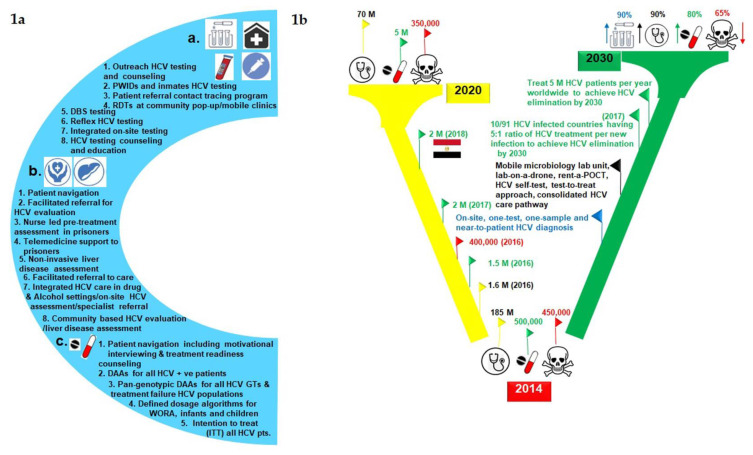Figure 1.
HCV care cascade strategies and WHO goals of HCV elimination by 2030. (1a) represents HCV cure pathway strategies, policies, and procedures at diagnostic (depicted in (1a) as ‘a’), linkage to care (depicted in (1a) as ‘b’), and treatment uptake levels (depicted in (1a) as ‘c’). The diagnostic approaches, treatment choices, and measures to be taken, which one seems feasible to make rapid progress toward elimination goals for hepatitis C by 2030, and what should be the key focus are mentioned under each category. (1b) represents the comparison of HCV diagnosis, treatment uptake, and mortality before the DAAs era, HCV elimination goals achieved until 2020, and the targets for the next 10 years regarding HCV elimination efforts. The base of the symbolic letter, ‘V’, demonstrates how many people were infected, diagnosed, and died by HCV infection and associated hepatic co-morbidities in 2014 before the inclusion of all oral interferon-free DAAs to be administered for HCV treatment. The yellow pedestal of the letter ‘V’ indicates the achieved goals in respect to hepatitis C elimination by 2020 compared to the intermediary set goals of WHO for this period in 2016 (i.e., 30% decrease in new HCV incidences and 10% reduction in mortality). Green flags indicate the treatment uptake and cure of HCV patients with DAAs onward from 2014. Red flags indicate the decrease in mortality rate after treatment recommendation with DAAs onward from 2014. Yellow flags indicate an escalation of HCV diagnosis after advancing the screening and diagnostic procedures as well as initiating mass HCV screening campaigns. The green pedestal of the letter ‘V’ indicates the priorities to set, policies to design, strategies to implement, and considerable work to do enabling the world to eliminate hepatitis C as a major public health threat before, by, or beyond 2030. The blue flag indicates an urgent need for one-test, one-step, and one visit HCV diagnostic to achieve WHO goals of HCV testing and infection diagnosis (i.e., 90%) by 2030. The black flag indicates novel testing approaches and treatment models to implement while escalating HCV diagnosis and linkage to care in remote areas as well as in vulnerable HCV populations. The green flags depict that how many countries are on track to achieve the set goal of HCV elimination by 2030 and how many patients to be treated with pan-genotypic DAAs to enhance HCV treatment by 80% and 65% reduction in mortality.  = central lab,
= central lab,  = phlebotomy,
= phlebotomy,  = sample,
= sample,  = testing,
= testing,  = hepatic disease assessment,
= hepatic disease assessment,  = diagnosis,
= diagnosis,  = treatment,
= treatment,  = linkage to care,
= linkage to care,  = mortality,
= mortality,  = Egypt. PWIDs = Patients who inject drugs, RDT = rapid diagnostic test, DBS = dried blood spot, DAAs = direct-acting antivirals, GT = genotyping, WORA = women of reproductive age, POCT = point-of-care testing.
= Egypt. PWIDs = Patients who inject drugs, RDT = rapid diagnostic test, DBS = dried blood spot, DAAs = direct-acting antivirals, GT = genotyping, WORA = women of reproductive age, POCT = point-of-care testing.

